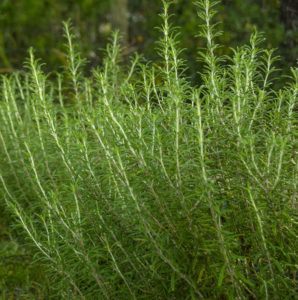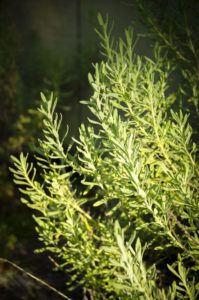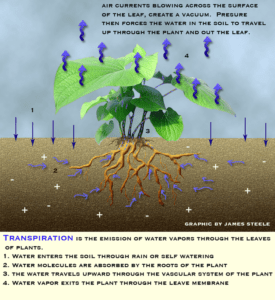
Transpiration is the process of water movement through a plant and its evaporation from aerial parts, such as leaves, stems, and flowers. Leaves of plants are covered with pores ( stomata ) and it is through these pores that water transpires or exits the plant…
![]()
It’s Summer, it’s hot and it’s humid. Afternoon and early evening rains drift across the sky and pick their spot. While the rains are a welcome necessity, and a natural part of our Summer weather pattern and the process of transpiration can present a bit of a problem for our Herb gardens.
First, let’s take a look at Transpiration…
Water is absorbed into the soil from rain or self-watering. The water molecules then interact with soil molecules and, in liquid form are absorbed by the plant through pores in the roots. This water, as well as any dissolved nutrients, travels up and down the plant through vascular tissues called xylem and phloem, and as the air pressure over the leaf surface changes due to breezes and wind, a vacuum is created and is filled with water vapors from the plant filling the vacuum. Let’s take a look at how herbs are affected by this…
Most herbs respond well to plenty of sunlight and can tolerate a lot of heat. After all, these conditions are what help contribute to the production of the oils we love so much. Some popular herbs however simply do not handle our wet, humid summer afternoons in July, August, and September. Rosemary, Lavender, Sage, and Thyme…four great herbs, often display the consequences of those humid, rainy afternoons. These herbs have several things in common that contribute to their problems….let’s take a look at two of them, Rosemary and Lavender…
ROSEMARY (Rosemarinus officinalis)

The thin, resinous leaves of Rosemary are a telltale sign that this plant does best in hot, DRY climates. These two characteristics, thin leaves, resulting in fewer stomata and a high amount of resin, which slows the process of water vapor exiting the leaf, minimize transpiration. As a result of a slower transpiration rate, Rosemary needs to be in well-drained soil and watered minimally. Outdoors, planted in the ground, Rosemary does best in soil with more sand content to allow for drainage. As the afternoon rains increase during the summer, it is important that the moisture in the soil isn’t retained for long periods. Avoid overhead sprinklers as a means of watering Rosemary as this add to the moisture in the air and impedes transpiration. In containers, be sure the drainage holes are not clogged. Often with older Rosemary plants, the root system will eventually block the drainage hole, which will result in the container holding more moisture. During a rainy summer, this extra water around the root system could eventually ‘drown’ the plant in a matter of days!
When growing Rosemary, give it plenty of sunlight and if you are going to err on the watering, err on the dry side. It can usually bounce back from being too dry but will most surely die if it is kept too wet. Avoid over-pruning Rosemary during the rainy summer months. When leaves are removed, remember, that you are removing the exit points of water during transpiration and as a result, you will actually compound the problem and limit the plants’ ability to remove water from the soil. Light pruning, perhaps no more than a third of the leaf area of any one branch, is my suggestion during these months. A heavier pruning during the drier, fall season is fine.
LAVENDER (Lavendula spp. )

Lavender is very similar to Rosemary in its characteristics relating to the effects of a rainy summer….thin, resinous leaves, both slowing down the process of transpiration. I hear more complaints about growing Lavender than I do about any other herb. In fact, people often share with me that they read how you can’t grow Lavender in Florida, which isn’t true at all! Lavender can definitely get an attitude during the humid, rainy months of our summers. Unlike Rosemary, Lavender is subject to the results of a fungus that works its way up from the soil line to the bottom leaves and could eventually kill the plants. In order to prevent this from happening it is important to provide Lavender with good air circulation, plenty of sunlight, and well-drained soil.
I have found that mulching Lavender made a difference in hindering this fungus to affect the plant. A number of years ago I did a test on mulches and Lavender and found that coarse builder’s sand worked far better than any other. The lack of organic matter as well as the great draining ability provided the best barrier between soil and plant.
If your lavender plant does show signs of leaf browning, starting from the lower leaves, you should minimize any watering and allow the soil to dry. Do not prune the plant! More so than with Rosemary, pruning a Lavender during the rainy summer months, especially when the plant is showing signs that it has a leaf fungus, is a sure way to speed up its death. Lavender is a Mediterranean herb and loves the hot dry air, not Florida’s hot, humid and wet summers. Like some of us during those months, it gets an attitude and the best thing for someone with an attitude is to do what you can and then leave them alone. Do any cosmetic pruning during the drier fall months in order to encourage new growth.
![]()



